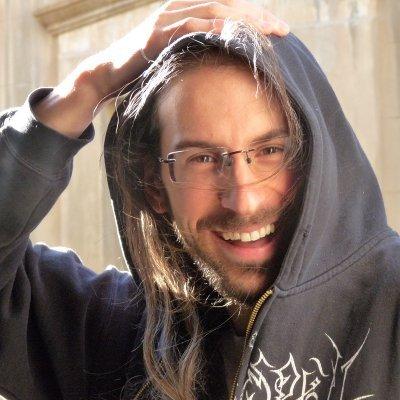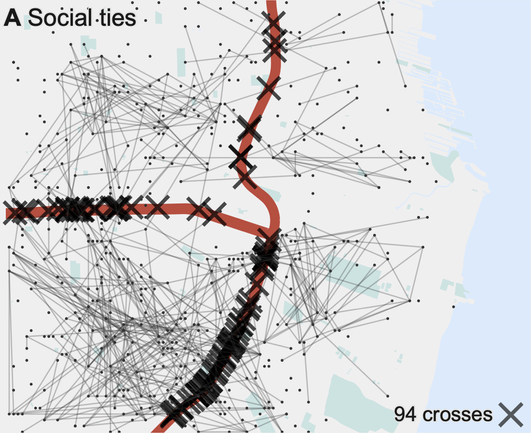Luca Maria Aiello becomes Full Professor
https://nerds.itu.dk/2025/04/01/luca-maria-aiello-becomes-full-professor/
Congratulations Luca @lajello, well deserved! 🎉👨🏫
Associate professor of Data Science @ITUkbh Copenhagen, member of @nerdsitu. Formerly @BellLabs, @YahooResearch, @IUBloomington, fellow of @ISI_Fondazione.
Hear our @lajello, interviewed by @Streetsblog , explain in The Brake podcast the motivation and results of our recent paper on highways and their significance to urban planning, with a "lovely" Italian accent 😄👌
https://usa.streetsblog.org/2025/03/11/how-highways-rend-our-social-fabric-and-the-challenge-of-mending-it
@BeTongLen we map highways using OpenStreetMap's "motorways" (https://wiki.openstreetmap.org/wiki/Tag:highway%3Dmotorway). In the paper's supplementary information you can find experiments with streets of different traffic capacity (tldr; the effect diminishes for narrower, less trafficked streets, as one would expect)
🎉 New paper in PNAS: Urban highways are barriers to social ties
https://www.pnas.org/doi/10.1073/pnas.2408937122
Highways are barriers that cut opportunities for social ties. We quantify this effect by overlaying the US highway network with millions of social ties from Twitter.
Great collaboration with @anavybor @mszll @sandorjuhasz and and Eszter Bokányi.
Cover image credit Karo Berghuber (Insta: @kariot.lines)
Reducing social connectivity ultimately harms economic opportunities of lower socioeconomic classes. Therefore, it is important to promote urban restorative initiatives such as the Reconnecting Communities Program by the US DoT (https://www.transportation.gov/reconnecting), recently discontinued by Trump.
The effect is especially strong at short distances (<5km), persists after controlling for sociodemographic factors and other barriers (e.g., rivers), and is consistent with historical cases of highways that were built to purposefully disrupt or isolate Black neighborhoods.
"Urban Highways Are Barriers to Social Ties" out on PNAS!
The 1st large-scale measure of how highways weaken social connections between the communities they separate.
This barrier effect is strong in the 50 largest US cities and especially for low-income Black communities.
https://www.pnas.org/doi/10.1073/pnas.2408937122
🔥 Are you working on next-gen or alternative social media platforms like #Bluesky or #Mastodon?
👇🏻 This #ICWSM2025 workshop is for you! 😎
📢 https://nextgensocial-workshop.github.io/
📚 We solicit research, position, demo, and dataset paper submissions!
📆 Submissions: March 31, 2025
Most tests for LLM biases use questionnaires, asking the model to generate a stance towards a given topic. Sadly, biases can re-emerge when the model is used in the application context. We show that apparently unbiased LLMs exhibit strong biases in conversations.
Preprint: arxiv.org/abs/2501.14844
Meet NERDS 👋 We're 27 researchers at #ITU #copenhagen studying how data, networks, and AI shape society! We use #datascience science to decode everything from social networks to urban systems - and we're big fans of bikes! 🚲
Stay tuned as we share more about the cool stuff we're working on!
https://nerds.itu.dk/
New preprint out! 📰
We explore how Large Language Models (LLMs) autonomously develop social conventions through interaction, and found that seemingly unbiased LLMs exhibit "collective biases" when interacting with other agents.
We ought to look at AI biases *within application contexts*, not simply by probing models in isolation.
Great collaboration with Andrea Baronchelli and Ariel Flint Ashery (Queen Mary University of London) @nerdsitu
Testing LLMs in Game Theory experiments reveals their moral biases as social agents -- useful to inform alignment. Llama2 playing Prisoner's Dilemma is more forgiving and non-retaliatory than humans, but only when the opponent defects rarely. New preprint: http://arxiv.org/abs/2406.13605 @nerdsitu
Testing LLMs in Game Theory experiments reveals their moral biases as social agents -- useful to inform alignment. Llama2 playing Prisoner's Dilemma is more forgiving and non-retaliatory than humans, but only when the opponent defects rarely. New preprint: http://arxiv.org/abs/2406.13605 @nerdsitu
Hey Jim Bagrow (https://bagrow.com) and I wrote a book called "Working with Network Data"!
Compared with existing books, we focus much more on the practical (data science) side of network science.
You can preorder it now!
Amazon: https://www.amazon.com/Working-Network-Data-Science-Perspective/dp/1009212591
Cambridge: https://www.cambridge.org/network-data
New NERDS paper out on Machine Learning in Humanitarian Work
https://nerds.itu.dk/2024/05/24/new-nerds-paper-out-on-machine-learning-in-humanitarian-work/
I recently concluded 2 urban #datascience projects that I dreamt of doing since a long time, with 2 super talented MSc students who visited us @nerdsitu last year from Germany, Carlson @cbueth and Henrik Wolf.
superblockify: https://arxiv.org/abs/2404.15062
CoolWalks: https://arxiv.org/abs/2405.01225
📢 New preprint: Urban highways are barriers to social ties: https://arxiv.org/abs/2404.11596
We overlay the highway network with a massive, geolocated online social network (Twitter 2012), and measure how social ties are impacted by highway segments. We find a strong barrier effect in all 50 considered US cities. See below - the red squares show that this effect is stronger for short distances.
@TheWarOnCars #geospatial #urbanism #segregation #datascience
Call for contributions for #ASONAM'24, to be held in Rende, in sunny Calabria ☀️.
Paper deadline: April 15th, workshops & tutorials proposals: March 20th.
Contributions from Network Science, Data Science, Computational Social Science, and Machine Learning are welcome!







